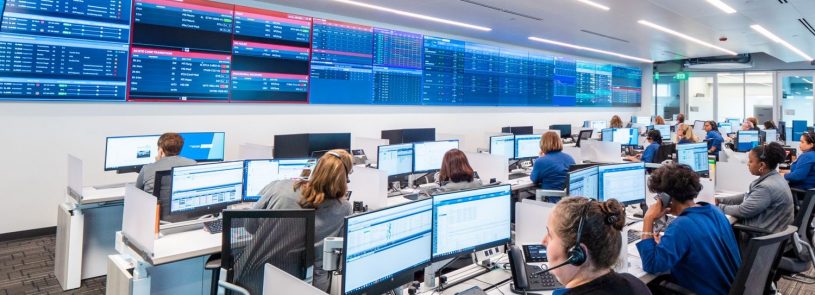Care command centers: Traffic control for healthcare improves outcomes and efficiency

AdventHealth’s new Mission Control in central Florida is the largest healthcare command center of its kind.
By Corey Gaarde and Mike Lawless
Getting a single aircraft and its passengers off the ground and safely back down again does not rely on the pilot alone – a team of air traffic controllers with a birds-eye view supports, guides, directs, and manages the flight path. What if healthcare systems adopted this model for patient care?
A select few already have – expanding the concept already used for centralized operations and management of building controls and public safety to the realm of patient experience. Much like air traffic control, these “care coordination command centers” employ a team of experts who manage a holistic patient experience of care, ensuring the best outcome for each individual and the most efficient use of resources for the healthcare system.
World-renowned Johns Hopkins Hospital set the example in 2016 with its Capacity Command Center, showing that centralized operations can improve patient outcomes and streamline hospital functions. By using advanced technologies and artificial intelligence, the NASA-like operations of the center provided a 60 percent improvement in transfers from other hospitals and a 70 percent reduction in transfer delays from OR post-procedure.
More recently, AdventHealth’s Central Florida facility opened Mission Control in response to the hospital having met its capacity in 2016. The $20M, 12,000-square-foot center with custom dashboards, 60 LCD displays, and dozens of workstations is staffed by nurses, EMS and flight dispatchers, transport techs and other specialists. According to the healthcare system, the center has streamlined the patient experience and “uses artificial intelligence to inform and guide decision-making in areas including ambulance and helicopter dispatch, patient transfers between units and facilities, and prioritization of placement and treatment.”
Care coordination command centers like these are worthy of consideration by the countless healthcare systems who are evaluating new care models for maximizing efficiencies in response to COVID-19 – much like the small hospitals in rural areas who are leveraging telemedicine command centers to meet the influx of patients amid ICU bed shortages. Any such pursuit, however, should consider inclusion of the following functions:
- Omnichannel contact center
- Patient resource center
- Video surveillance and tele-sitter
- eICU or eAcute care
- Patient monitoring/telemetry
- Clinical communications and collaboration (e.g., nurse call versus request for ice)
- Patient/family experience (e.g., ordering food, requesting a blanket)
- Telemedicine service lines
- At-home patient monitoring
- Public safety
- Facilities and environmental monitoring
- Energy management
The technology to support care coordination command centers is not an issue – it is available now, and currently being utilized in the separate spaces that would come under one roof. The infrastructure also needs to have resiliency for power, data, and HVAC to avoid disruptions. In addition, the infrastructure investment can be more cost efficient if the center and other offsite mission critical functions – such as offsite Central Sterile Services – are grouped together in a common building.
As proven by Johns Hopkins and AdventHealth, consolidation of hospital system functions via a care coordination command center can be very successful. Such an endeavor, however, requires collaborative and innovative effort by healthcare designers, engineering firms, manufacturers, and caregivers to design a center that increases efficiency, improves operations and, most importantly, provides optimum patient and care team satisfaction.













